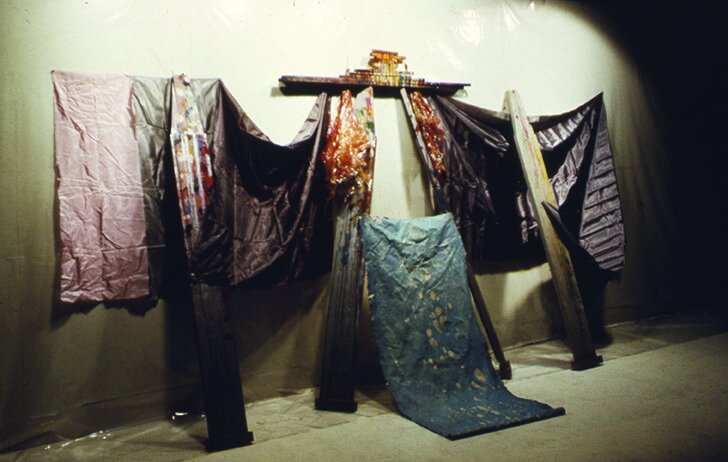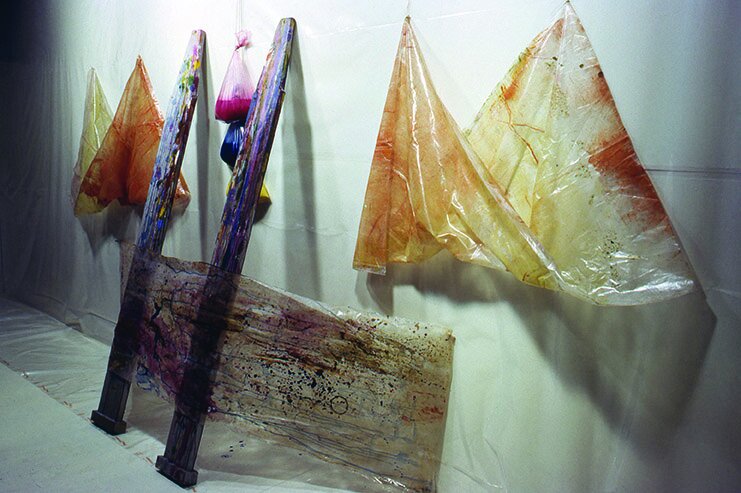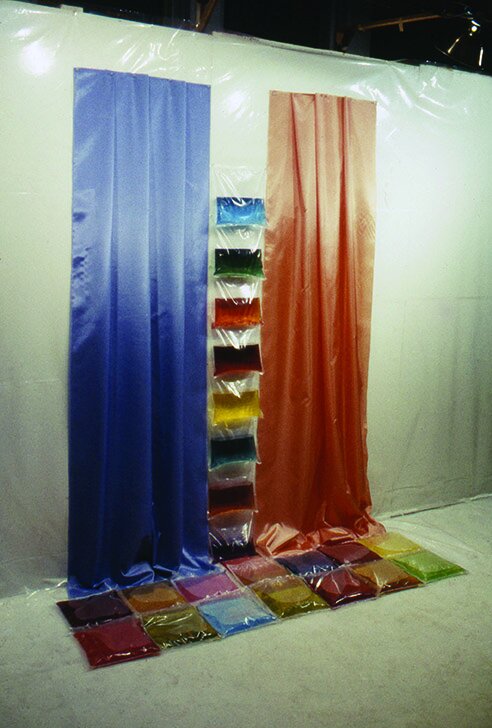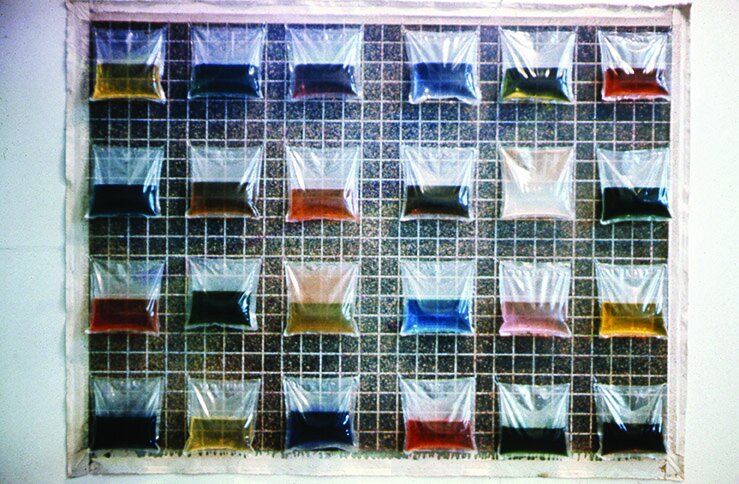Route 44 - A Journey, Chapter 5
Chapter 5
The Mid-Way Show was a success and the museum retained one piece for their permanent collection. This was an honor or at least I thought it was at the time. I often wonder what became of that piece or if it was ever shown again. The influence from my fellow grad students was really beginning to affect my thought process and I was slowly starting to experiment with different materials. The entire time I was working with the wrinkle technique I was obviously working with an illusion of depth or space and I was trying to enhance or destroy this illusion with color and texture. I slowly started to play with this deconstruction using alternate materials like Plexiglas suspended in front of the wrinkle to visually prove the flatness. Then I started playing with making the wrinkle permanent with the use of polyester resin to stiffen the canvas. This led to combining the Plexiglas with the resin, then using the resin on lighter weight material i.e. muslin, then tinting the resin with dyes and paint, then casting separate elements of paint to apply or arrange on top of the other materials. Yea, you got it, lots of crazy experimentation but that is what graduate school is for or at least at OU (total freedom.) Now that I look back on it, what a wonderful time and place! All this experimentation and Otis’s influence eventually led to some arranged pieces. These pieces were similar in size and style to Otis’s work but I changed the materials slightly. Honestly, they weren’t very good and certainly lacked the passion and commitment that Otis and Dalton had with their work. It never happened but I think if almost anyone would have come in and told me that my work sucked and I was full of crap for even trying it, I would have agreed with them, stopped immediately and started something else. I truly was not committed to this type of work! I think of this work and this time period as a transitional period but even with my lack of commitment the effort and the exploration led to new developments in concept as well as process. I became acutely aware of the individual materials that I was choosing and their visual impact on the finished pieces. In traditional painting processes the materials are combined together to create a work where the individuality of each element was hidden in the totality of the whole. In these arranged pieces all the elements remained visible and uniquely separate from the whole. Each element had a distinctive visual effect on the finished piece. This was a new concept for me and I started working with this concept and its relationship with traditional painting materials. In particular I became intrigued with the idea of separating the materials completely yet still having them combine visually. This idea led to separating the paint from the canvas and the canvas from the stretcher frames and bringing them back together in a new presentation. About this time I found an old heat seal machine at the government surplus that I mentioned earlier. This machine was a bulky set of steel bars that were configured into a clamp that was hydraulically operated by compressed air. The bars of the clamp were coated with Teflon and heated to a high temperature so you could put two pieces of polyethylene plastic in and clamp it for about 30 seconds and it would melt the two together. I started using this machine to seal 12”x12” clear pieces of polyethylene plastic on three sides, then fill the bag with colored water then close or seal the remaining side. The end result was a clear plastic bag with colored liquid inside. These bags became my solution to separating the paint from the other elements. This led to an entire series of pieces that were visually a little more structured than the arranged work. This work definitely pushed the boundaries of sculpture and painting. I always thought of them as paintings even though some of the pieces were freestanding, floor structures. I thought of them as paintings because conceptually they were conceived from painting concepts. There was an interesting occurrence dealing with this controversial aspect of these pieces. During the fall semester of 1972, the Museum sponsored a painting competition for students. The competition was open to all art students including graduates. It was a juried competition and the juror was not from OU. I entered one of my bag pieces in the competition and installed it early on the deadline date. These pieces were separate components that I had to set up or arrange. The deadline for entries was 5:00 pm and about 4:00 pm the Director of the Museum, Sam Olkinetzky, contacted me and told me my submission was unacceptable. I asked him why and he said that the competition was for painting and my entry was not a painting. I tried briefly to argue with him using the logic that I created it and the concepts were all painting concepts, but I could see that I was getting nowhere so, I left angry. I went directly back to the art building and ran into George Bogart. He could see that I was distraught and asked me what was going on. I told him the whole scenario, he thought for a moment and told me that I should go back over and talk to him again. My immediate reaction was “Why, what’s the point.” George just looked at me and very calmly said, “If you don’t, he wins.” I certainly didn’t want that and I suddenly realized that George was right. I talked with George a little more to plan my strategy. He suggested that I calmly ask Sam what constitutes a painting and what distinguishes a painting from sculpture. I waited a few minutes and went back to the Museum. I found Sam and engaged him in the planned discussion. I asked him what his definition of painting was. At first he was combative, but I worked calmly and tried to convince him that I was trying to understand. He replied that a painting was all about color and that it could not be dimensional. I then asked him if shaped canvases and work like Frank Stella applied. He replied of course not because Stella was a recognized national painter. I then asked if the fame or notoriety of the artist had anything to do with determining weather a work was sculpture or painting. He replied that it did not. He continued to tell me that the work could not be dimensional. We discussed other dimensional painting techniques and other recognized artists and finally I asked him how far from the wall could a work project before it became sculpture. He was hesitant but finally said that a painting could not project from the wall more than 12 inches before it became sculpture. I then asked if I rearranged my work so that it did not project more than 12 inches, would it be acceptable. I had him; he reluctantly said, “I guess so.” I quickly went to where my piece was hanging and rearranged it by shoving all the ladder forms up against the wall so they did not extend more than 12 inches. It looked terrible but at least it was shown to the juror. A temporary victory! The true irony came after the juror reviewed all the work and awarded my piece the best in show award. He did comment that he thought the piece would be even better if the ladders projected further onto the floor. I renamed the piece “Sam’s Grief.” This event taught me a lot about the art of negotiation and how a cool head and rational discussion could be a strong asset. Later in life this lesson became extremely valuable in dealing with Design clients, distraught students and the dreaded “helicopter parent.”
Stacked Arrangement 80″x120″x36″
Freezer Bags 80″x120″x24″
Three Stall Holding Station 48″x80″x16″
Formal Bags 88″x60″x24″
Wrinkle Bags 72″x96″
Glad Bags 72″x132″
Painting on Painting 60″x90″
Sam’s Grief 60″x90″x72″
Construction Bags 96″x96″x12″










